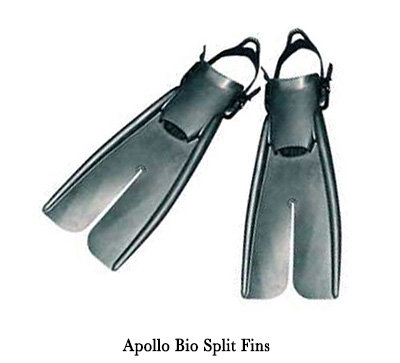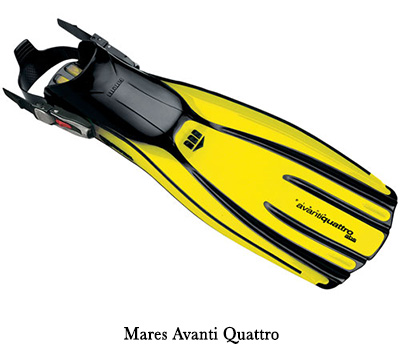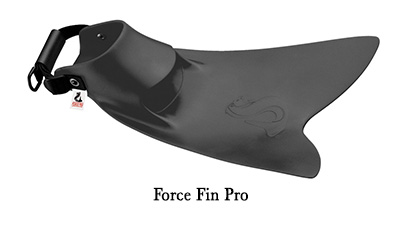What Fins Do You Fancy?Contents of this Issue: Kona Aggressor II, Kona, Hawaii Strobes Don’t Damage the Marine Life Should You Let the “Dentists of the Sea” Clean Your Teeth? Scubaqua, St. Eustatius, Dutch Caribbean Do These So-Called Shark Repellants Keep Sharks at Bay? The Fatal Effects of “Rapture of the Deep” Can a Fish Tell If a Scuba Diver Is Armed? Is Menopause a Cause of the Bends? Is Your Old Computer Still Safe? Your Next Dive Safety Device Might Be . . . an Underwater Tent? Shark Fins Are Banned in 12 U.S. States -- But It’s Still on the Menu Editorial Office: Ben Davison Publisher and Editor Undercurrent 3020 Bridgeway, Suite 102 Sausalito, CA 94965 our reader feedback is as varied as there are fin types from the March, 2019 issue of Undercurrent
Thanks to all you readers who gave your feedback regarding my article last month about how traditional, heavy, hard-rubber fins are enjoying a partial renaissance. But it's not so much that Undercurrent subscribers are reverting to traditional hard rubber fins - some never stopped using them. Others disdain them and prefer lighter ones -- because most Undercurrent readers travel to distant shores to dive, the weight is a consideration, too. Overall, opinions on the types of fins you prefer seem to vary as much as the locations where you live. Over two decades, I made quantifiable comparison tests on the efficacy of many different fins for Diver magazine in the United Kingdom. I used teams of divers of varied build and ability, scientific instruments such as underwater speedometers, and speed swims against the clock. These tests revealed the efficiency of a fin for transferring muscle power into the ability to push on into an oncoming current. I found that because a fin becomes an extension of your leg, different fins had different results with different-length legs. Moreover, while some split fins proved very effective, they were no more effective than the best paddle fins, while the worst-performing split fins were not as good as basic paddle fins. The typically shorter foot pockets of traditional hard rubber fins put more stress on calf muscles but were effective for those built strongly enough to use them. Here's a summary of the reader feedback we got on favorite fins, and good reasons for why those divers preferred them. If you're looking for a new pair, let's see whose tribe you join. Traditional Hard Rubber Fins Glen Kitchens (Cedar Crest, NM) has been using the same pair of traditional Dacor Turboflex fins for 30 years. The only change he has made to them was to add spring-loaded heel straps because he got tired of replacing broken rubber straps. As he puts it, "Just because they're old doesn't mean they're over the hill!" Suzanne Leeson and David Vickery (Hoboken, NJ) wrote of their Dive-Rite foot pocket fins with spring-loaded straps that "seem to naturally pivot to the side for a frog kick but provide lots of propulsion in a flutter kick when needed." However, Vickery added, "The only trouble I've ever had was when I was crammed into an RIB on the Red Sea with eight other divers. I was sitting opposite the center console and there was no room for my size-13 feet, let alone my fins. I twisted my foot to the side to relieve the pressure on my ankles, and a spring strap snapped." Ben Sturm (Frisco, TX) says he still uses the first set of fins he purchased for his openwater training in 1992. "They are Wenoka Reeflex hard rubber fins with very stiff side rails, and three inserts to stiffen the blade. I simply love these fins." Don McCoy (Portland, OR) bought a pair of traditional Scubapro Jet Fins 45 years ago and says they are bulletproof. "The fins work fine up here in the Pacific Northwest, as well as in the Caribbean, Sea of Cortez and Cocos. I really haven't been tempted to buy anything else." My verdict: They're not for everyone. The tests I ran for Diver proved that only divers with short, powerful thighs could get anywhere near a competitive performance from this type of fin, typified today by Apeks RK3 and Hollis F1. Split Fins
We got a few votes for the Apollo Bio fins. Dan Zielinski (Jefferson, NY) wrote, "They're heavier than my Tusa Zoom split fins, but work just as well. If I want to move fast in my drysuit, I use the Bio Fins because of their negative buoyancy." Rick Huggins (Salem, MO) likes the spring straps. "They make it easy to put fins on and they remain snug during the dive. They're good in a current and very fast." Douglas Peterson (Naperville, IL) says it was Apollo Bio Fin Pro split fins that caught his eyes around the time that split fins were the new cool thing. "First dive -- instant love. I agree with the claimed physics that it isn't how hard you kick for a short burst into a current, it's how long your cardio will hold out while working your way through the current." Lois Barbro (Cincinnati, OH) loves her Atomic Split Fins. She says, "Easy to dive with and they have plenty of power. They have lasted for 15-plus years of great diving and they still have the original straps." Tony Anderson (Buffalo, NY), a diving instructor with lots of experience under his belt, dove for over a decade with "engineered" high-performance fins and loved them, but after a leg injury, he went to a rubber split fin to lower the impact on his legs, and discovered he actually liked them better. But he adds this word of caution: "There are both rubber and thermoplastic split fins on the market. They do not behave the same in the water, and the [heavier] rubber fin has better characteristics." Safety diver Estevan Martinez (Los Angeles, CA) echoes Anderson's concern. "Our team uses the Scubapro [Twin Jet] split fin, and some of us regret it. Although it may help in elevating cramps and such, it's probably not the best fin for quick emergency deployments, as we have found that it doesn't seem to give the burst of resistance needed to move you through the water quickly." My verdict: How good they are depends on the brand. Diver tests proved conclusively that split fins including the Atomic, Apollo (despite a shorter foot pocket), Mares Raptor and Scubapro Twinspeeds were incredibly effective, whereas soft Scubapro Twin Jets were much less so. Technopolymer Paddle Fins These lightweight fins have always performed better in scuba magazines' tests than the traditional hard rubber fins, because they tend to have bigger blades, use several different materials in combination to control the flex of the blade, and, being lighter, take less effort to shift through the water.
Jonathon Blake (La Verne, CA) loves the Scubapro Seawing Novas he has had for at least 10 years. "They are powerful enough to push through strong currents, and great for a burst of speed. They took some adjusting for remaining in a horizontal position and trying to make a rotational turn just using your fins while taking photos or video). The only problem was going from slim warm-water boots to thick cold-water boots -- the bungee-type strap on them was just too tight." But Donna Farrell (Hilton Head Island, SC) likes those bungee straps. "They make it easy to get the fins on and off, especially when coming back to a dive boat and there's a line-up for the ladder. They're also lightweight, which helps when packing them to fly to dive destinations." Richard Wickenden (Plymouth, MA) owns five pairs of fins, but only one pair ever gets used. "The Mares Avanti Quattros with the spring straps are the best fins ever." Maggie May Nahas (Baton Rouge, LA), age 73, says that before her knees gave out, her favorite fins were the Quattros. "Excellent speed, maneuverability and stopping quickly by flaring out!" Theo Korol (Seattle, WA) has mixed feelings about her Quattros, which only come in small, regular and extra-large sizes. She was loaned a pair of them while on a Raja Ampat liveaboard because she was having difficulty with softer ones in the current; then she bought her own. But at 5'3" and with a size 8 foot, she noticed a problem with them on a Philippines trip last August. "The foot pockets are too large, particularly the width, so I was moving in my fins laterally, which not only impacted my kicking, but created blisters. I had to add double socks to manage the trip." She already owns the small ones, and Mares told her there's no extra-small available. Mike Hofman (San Francisco, CA) goes for simple Mares full-foot fins because they are less expensive yet they appear "to provide a great deal of power." The Mares Avanti Quattro Power is a fullfoot fin with a longer blade, originally intended for spearfishing and freediving. Jeff Hauser (Telluride, CO) says, "They are the fins of choice for a bunch of us regular Cozumel divers, including most of the divemasters and instructors at Aldora Divers. If you want to be able to play in current, it is definitely the way to go. It does require some leg strength, but we love 'em." Over-length freediving fins are the choice of dive instructor Robin Burr (Coral Gables, FL). She recently bought the new Cressi Gara Modular Nery to replace a worn-out pair of Ronda Gara, and really loves them. "They give you a wonderful, long, fluid kick, and the foot pocket actually comes with an insert designed with an arch. It is very comfortable and is positioned under the actual blade, so there is no pressure on any portion of your foot or ankle while dispersing the energy, which also means there is no cramping." My verdict: Mares rules. Its Quattro fins and variations of it, like the Mares Excite and the lighter-weight Mares X-Stream, outshone all other paddle fins in the Diver tests, while Scubapro Seawing Nova fins came close in effectiveness. Mares Volo got a "meh" rating. Force Fins
"I've been using my Force fins for 30-plus years," says Mickey Rosenberg (Providence, RI). "As the oldest (60-plus) diver on a Cocos Island trip 12 years ago, I had no problem keeping up with the others, even in strong currents." Charlie Killam (Wilmot, NH) also uses the Force. "They are the most comfortable, with or without booties; they provide plenty of power for the highest currents; they are good fins for both scuba and skin diving; they are very easy to don and doff." Mark Rosenstein takes a lot of ribbing on dive boats for the funny-looking short fins, "but I find them plenty powerful, extremely maneuverable, and they are small and light to pack." John McTigue (Rockport, MA) says his favorite is the Extra Force, for four reasons. "They've got the kick when you want it but won't cramp you up; the bungee strap is quick and easy; the foot pocket is large, smooth and comfortable; and kicking with the fin pushes it farther on to your foot, so you barely need a strap." My verdict: If you can supply the rapid flutter kick appropriate for these fins, the Force Fin Pro and Excellerating Force fins (with wings) work well, but at a huge purchase price. Other Bob Evans designs proved less effective in tests. The Two Most Important Factors As a wrap-up for this story, I like what underwater photographer David Hass (Stow, OH) says about the wide variety of fins he has used over the years. (He used Force Fin Pros for many of those years, up to five dives a day, from the warm waters of Papua New Guinea to the 45-degree temps of Port Hardy, British Columbia, and they always worked fine.) "People who opt for a stiffer fin usually regret it, and the physical condition of most sport divers isn't adequate to push a stiff fin. No fins have power -- the power comes from your legs and technique. Being young, I could kick stiff heel strap fins. The obsession with frog kicking versus shorta light flutter kick is something I've also challenged." Sage words. The choice of fin is as varied as the people who use them. If you choose open-heel fins, our readers universally agree that spring-straps or bungee-style straps keep your boots tightly in place, making the fins truly part of your leg. The best advice I can add to that is to find a pair of fins you like and stick with 'em. -- John Bantin |

I want to get all the stories! Tell me how I can become an Undercurrent Online Member and get online access to all the articles of Undercurrent as well as thousands of first hand reports on dive operations world-wide
| Home | Online Members Area | My Account |
Login
|
Join
|
| Travel Index |
Dive Resort & Liveaboard Reviews
|
Featured Reports
|
Recent
Issues
|
Back Issues
|
|
Dive Gear
Index
|
Health/Safety Index
|
Environment & Misc.
Index
|
Seasonal Planner
|
Blogs
|
Free Articles
|
Book Picks
|
News
|
|
Special Offers
|
RSS
|
FAQ
|
About Us
|
Contact Us
|
Links
|
3020 Bridgeway, Ste 102, Sausalito, Ca 94965
All rights reserved.

 Richard Mertz (Mount Pleasant, SC) loved his
split fins, but there was a big but. "They were
heavy, and when I tried to learn to go backwards,
I found out I could not with those fins. I learned I
needed a pair of fins that are pretty stiff in order
to go backwards."
Richard Mertz (Mount Pleasant, SC) loved his
split fins, but there was a big but. "They were
heavy, and when I tried to learn to go backwards,
I found out I could not with those fins. I learned I
needed a pair of fins that are pretty stiff in order
to go backwards." Steve Bissell (McLean, VA) switched from the
split fin "and pseudo whale-tail fin" to a more
traditional Scubapro Jet Sport paddle fin "because
I was concerned the split fin did not give me
enough propulsion in heavy current."
Steve Bissell (McLean, VA) switched from the
split fin "and pseudo whale-tail fin" to a more
traditional Scubapro Jet Sport paddle fin "because
I was concerned the split fin did not give me
enough propulsion in heavy current." These avant-garde fins are individually cast
in solid polyurethane by their California-based
maker, Bob Evans, and are promised to last indefinitely,
but divers either love them or hate them.
The Undercurrent subscribers who wrote in were
all in the former camp.
These avant-garde fins are individually cast
in solid polyurethane by their California-based
maker, Bob Evans, and are promised to last indefinitely,
but divers either love them or hate them.
The Undercurrent subscribers who wrote in were
all in the former camp.